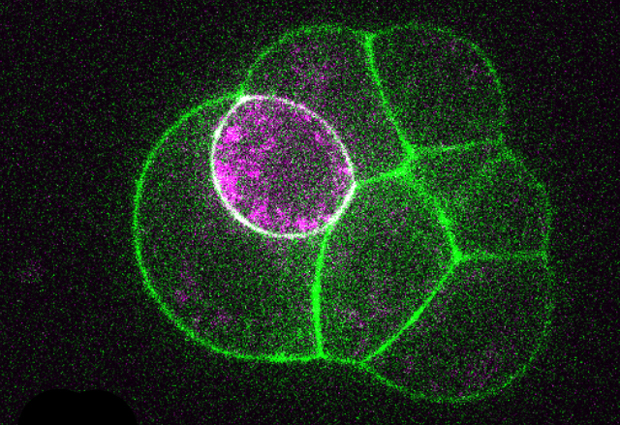The force is strong with embryo cells
Strength of contraction determines whether cells become embryo or placenta

In a nutshell
- Cells that will develop into the embryo must contract 1.5 times more than those that will become the placenta
- Cells destined for placenta stop ‘dancing’
- Knowledge could one day be useful for pre-implantation diagnostics on IVF embryos
For a cell in an embryo, the secret to becoming part of the baby’s body instead of the placenta is to contract more and carry on dancing, scientists at EMBL have found. The study, published today in Nature, could one day have implications for assisted reproduction.
After a sperm cell fertilises an egg cell, that fertilised egg divides repeatedly, forming a ball of cells. Shortly before the embryo implants in the womb, some of those cells move inwards. These are the cells that will develop into all the baby’s body parts. The cells left on the surface will become the placenta, connecting the embryo to the mother’s uterus.
EMBL group leader Takashi Hiiragi and Jean-Leon Maître, then a postdoc in Hiiragi’s lab, found that, in a mouse embryo, whether a cell moves to the middle or stays on the surface depends on how strongly it can contract. Teaming up with François Nédelec and Hervé Turlier, a postdoc in Nédelec’s lab, the scientists combined experiments and computer modelling, and determined that cells that contract at least one-and-a-half times more strongly than their neighbours move inwards.
But why do some cells contract more than others? The answer, the EMBL scientists found, is that they receive unequal inheritances: different amounts of apical proteins, molecules that stop the cell from contracting. Cells that inherit small amounts of apical proteins contract more, and move inwards to give rise to the embryo. By contrast, cells with large amounts of apical proteins contract less and stay on the surface, becoming the placenta. But when the EMBL scientists prevented all cells from contracting, they were surprised at the result.
“We found that if you interfere with contractility, the cells stay at the surface. But instead of becoming placenta cells, as you’d expect, they become embryonic,” says Maître, who is now setting up his own lab at Institut Curie in Paris. “This tells us that sensing the forces around them may be important for cells to know where they are, and what to become.”
Last year, the EMBL scientists discovered that in the first few days of an embryo’s life, all its cells perform a little ‘dance’, as a wave of contraction sweeps around their surface. The scientists now found that when the embryo is 3 to 4 days old, the cells that will become the placenta no longer dance.
instead of becoming placenta cells, as you’d expect, they become embryonic
Although the study looked at mouse embryos, the first stages of development are similar in mouse and human embryos, so the researchers expect their findings to hold true for our own species. If so, they could one day be relevant for researchers and clinicians doing pre-implantation diagnostic tests on in vitro fertilised (IVF) embryos. Screening IVF embryos for genetic disorders before implanting them in the mother entails taking a cell from the embryo, to analyse its DNA. Knowing that cells which will become the placenta don’t dance may help clinicians to pick either placental or embryonic cells to test.
For their part, Hiiragi, Maître, Turlier and Nédélec will continue to investigate the fundamentals of how embryos take shape, and how differences between cells arise.
“We now understand a lot more about the mechanical aspect of how cells move inwards and become the embryo, but it’s also raised a lot of questions about how that is translated into gene expression,” says Hiiragi. “We’re also looking at other factors that could be involved, like how cells communicate, and sense contacts with each other.”



